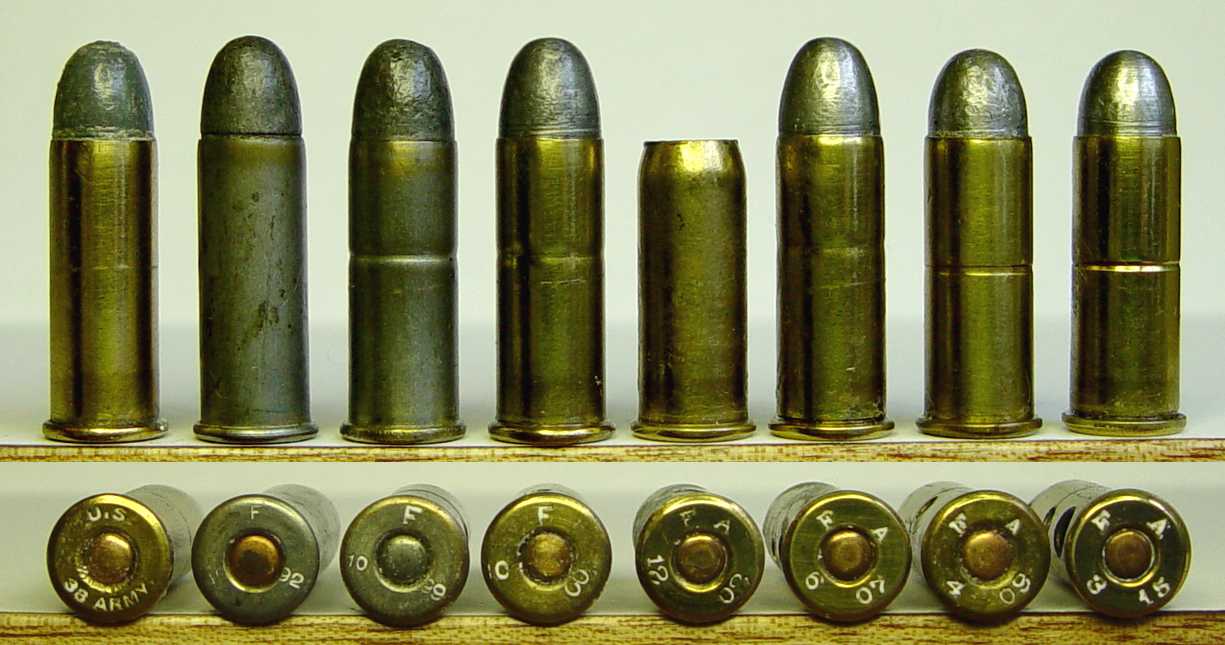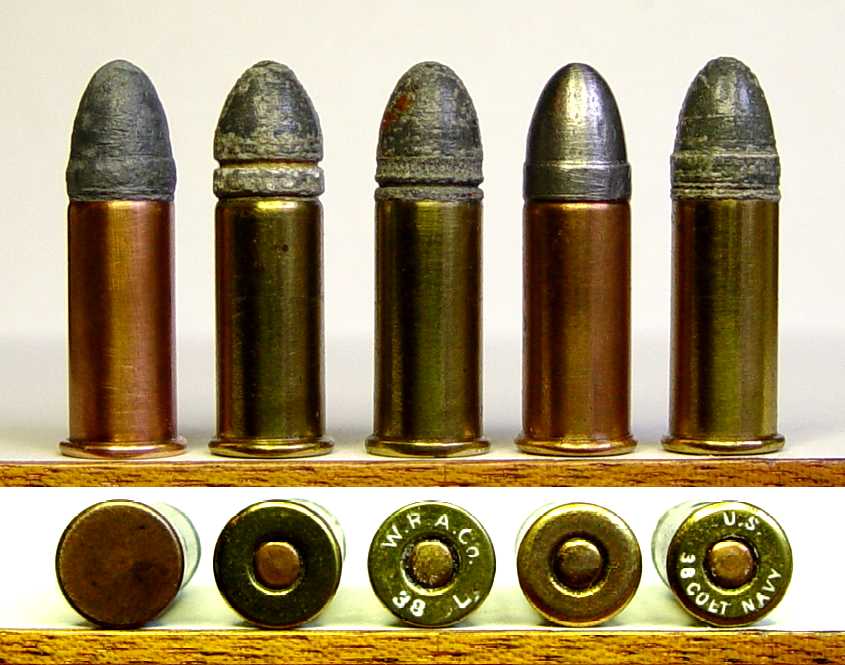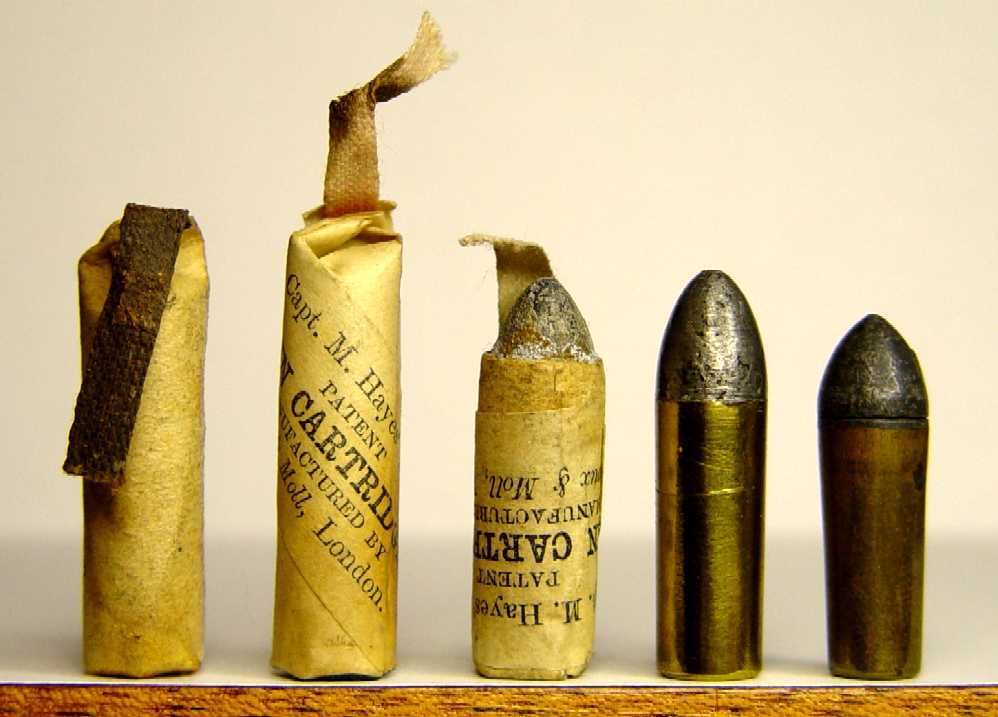|
THE CARTRIDGE COLLECTOR'S EXCHANGE |
| Contents
Cartridge
Lists Links to Other Sites
Cartridge Collectors Organizations:
Auctions:
Books:
Other Collector's Sites: |
Home of the Old Ammo Guy's Virtual Cartridge
Trading Table
Featuring a wide range of antique, obsolete,
and modern ammunition for collectors
August 2004
Here is a group of .38 Army or Long Colt cartridges which reflect various changes that were made in the design of the cartridge during its military life. The .38 Long Colt traces its origins to the .38 Long centerfire, an outside-lubricated cartridge developed by Colt in 1874 for their New Line revolvers and the centerfire conversions of their .36 caliber percussion revolvers. With the introduction of Colt's New Navy double action revolver in 1889, this cartridge became known as the .38 Colt Navy. In 1892, an improved, inside-lubed version of the cartridge having a lengthened case was adopted by the US Army, and became known as the .38 Army (aka .38 Long Colt). The new cartridge was interchangeable with the outside-lubed Navy style, as they had essentially the same overall length, and the older cartridge soon became obsolete.
Shown here are eight variations of the .38 Long Colt. The cartridge on the left was manufactured by the United States Cartridge Company, probably shortly after the adoption of the cartridge by the Army, and intended for sale to a civilian market. The remaining cartridges were made at the Army's Frankford Arsenal, and span the entire 17 year period that they produced this cartridge. Production at Frankford Arsenal began in September of 1892; the headstamp on this first production cartridge was F 9 92. The earliest I have been able to locate for my collection is the second cartridge in the picture with the F 12 92 (December 1892) headstamp. The first cartridges were loaded with black powder and had folded head tinned brass cases without cannelures, copper primers, and two-groove lead bullets weighing about 148 grains. In late 1899, a cannelure was added to the case, about .370" to .380" from the case mouth, against which the bullet was seated in loading. At about this same time, the change was made from black powder to smokeless. The third cartridge in the picture, having an October 1899 headstamp, probably has the earliest headstamp to have the cannelure. In 1900, the tinning of the cases ceased, as shown on the fourth cartridge in the picture headstamped F 10 00. The folded head was changed to a solid head at about this same time. Throughout production, the characters in the headstamps varied in size and style, and often mixed different size characters in a headstamp. Originally, these cartridges had a three position headstamp, consisting of the letter 'F' for Frankford at 12 o'clock, with one or two digits for the month at 8 o'clock, and two digits for the year of production at 4 o'clock, as seen on the second, third and fourth cartridges. The fifth cartridge in the picture, the blank, is headstamped F A 12 02, illustrating a change made in the headstamp which occurred in November of 1902. The addition of the letter 'A' (for Arsenal) in the headstamp changed it from three positions, or components, to four. Note how close the two letters are in this headstamp; they were soon spaced further apart so that the components were 90 degrees apart, as shown on the three remaining cartridges in the picture. In 1907, a change in the manufacturing process for forming the case head produced a shallow groove just ahead of the rim, as seen on the sixth cartridge in the picture. In March of 1909, the case cannelure was moved slightly further to the rear, centering it about .430" to .445" from the case mouth. In April of 1909, a new bullet was adopted; while the bullet remained at about 148 grains, the grooves were significantly shallower, allowing the bullet to be shorter, resulting in a shorter overall cartridge length. The seventh cartridge in the picture, headstamped F A 4 09, shows both the repositioned case cannelure and the new bullet. The last cartridge in the picture, headstamped F A 3 15, is from the last known run of the .38 Long Colt at Frankford Arsenal in March of 1915.
Kissing cousins & other close kin to the .38 Long Colt......
I've included a picture here of a few of the cartridges which I touched on
above that are closely connected to the .38 Long Colt. Much activity went
on at Colt's Patent Firearms Manufacturing Company as it made the transition
from percussion to metallic cartridges. Only percussion firearms were made
by the company up to about 1870, due in large part to the virtual monopoly
that Smith & Wesson had on revolver development in the United States
as a result of their having obtained rights to Rollin White's 1856 patent
on the bored-through cylinder. White's patent protection expired in 1869,
after which any company was free to copy any part of his design in
producing firearms. The first true metallic cartridge handguns made by Colt
were their .41 rimfire deringers introduced in 1870, followed by an assortment
of rimfire revolvers introduced beginning in 1871. Also in 1871, Colt began
converting various models of their percussion revolvers to use metallic
cartridges, based on Charles B. Richards' patent, which was granted on July
25th of that year. An Army contract for converting the first of these percussion
revolvers was awarded to Colt in anticipation of the expiration of the
Rollin White patent in February of 1871, which required the company to convert
1,000 Model 1860 revolvers to use the .44 Martin primed centerfire cartridge
manufactured at the Frankford Arsenal. At this same time, Colt also began
producing cartridge revolvers for the civilian market based on their
1851, 1860 and 1861 percussion models, using converted percussion parts that
they had on hand as well as new made parts. The civilian 1860 revolvers
were produced in .44 Colt centerfire only; the 1851 and 1861 revolvers were
produced initially only in .38 rimfire. In 1873, the Navy contracted with
Colt to convert a number of their service Model 1851 and Model 1861 percussion
revolvers to use a .38 caliber centerfire cartridge that did not yet exist,
but which the Union Metallic Cartridge Company was in the process of developing.
That cartridge was in production by late 1873 or early 1874 as the .38 long
centerfire, which was a centerfire version of the .38 long rimfire, the
dimensions of the two being quite similar. Adoption of this cartridge
by the Navy Dimensions of the cartridges in the picture are: ____bullet_____mouth_____base_____rim__case length__length overall #1 .374" .377" .377" .441" .879" 1.360" #2 .383" .378" .378" .437" .877" 1.353" #3 .373" .376" .377" .434" .874" 1.345" . #4 .378" .377" .377" .426" .870" 1.340" #5 .379" .376" .376" .432" .871" 1.361" Dimensions of the .38 Long Colt: .349" * .377" .377" .431" 1.016" 1.324" * bullet measured at the case mouth, which has a smaller diameter than the base of the bullet
As well as a few of its predecessors.......
Here are some of the predecessors of the .38 long centerfire. The first three on the left are .36 combustible cartridges, still in their paper wrappers. The wrapper would be removed prior to loading the cartridge in the revolver by pulling on the cloth tab on the end. The first is unmarked except for an orange sticker on the base marked 'ELEY LONDON'. The maker of the second and third, Broux & Moll of London, England, recognizing the marketing potential of these paper wrappers, marked theirs 'Capt. M. Hayes", R.N. / PATENT / SKIN CARTRIDGE / MANUFACTURED BY ' Broux & Moll, London.'. The last two are .36 Thuer cartridges, the first for the Model 1851 and 1861 Navy percussion revolver conversions, and the second, the shorter and less common style, for the 1862 Police and Pocket Navy conversions. Thuer cartridges are rimless and taper towards the rear to allow loading from the front of the cylinder. Other than these two major differences, they are not unlike today's centerfire cartridges, being reloadable and having a replaceable primer in the center of the head. The Thuer design was one of many attempts to circumvent Rollin White's bored through cylinder patent, but as was the case with most of these, it proved to be impractical, and was soon made obsolete by the expiration of White's patent protection.
|


 resulted in it being designated by them as the .38 Colt Navy, and any cartridges
produced on contract for the Navy had to be so headstamped. The picture here
includes, from the left, an unheadstamped .38 long rimfire by the U.S.
Cartridge Company, an unheadstamped .38 long centerfire by the Union
Metallic Cartridge Company, another .38 long centerfire, this one made by
the Winchester Repeating Arms Company, still another unheadstamped by the
US Cartridge Company, and one headstamped 38 COLT NAVY by the U.S. Cartridge
Company. This cartridge was relatively short-lived, having been made obsolete
by the inside-lubricated .38 Long Colt, essentially the same cartridge with
a lengthened case to cover the grooves of the bullet and a redesigned bullet,
which replaced it in 1892.
resulted in it being designated by them as the .38 Colt Navy, and any cartridges
produced on contract for the Navy had to be so headstamped. The picture here
includes, from the left, an unheadstamped .38 long rimfire by the U.S.
Cartridge Company, an unheadstamped .38 long centerfire by the Union
Metallic Cartridge Company, another .38 long centerfire, this one made by
the Winchester Repeating Arms Company, still another unheadstamped by the
US Cartridge Company, and one headstamped 38 COLT NAVY by the U.S. Cartridge
Company. This cartridge was relatively short-lived, having been made obsolete
by the inside-lubricated .38 Long Colt, essentially the same cartridge with
a lengthened case to cover the grooves of the bullet and a redesigned bullet,
which replaced it in 1892.
